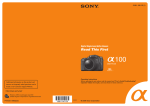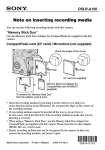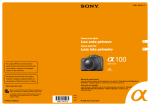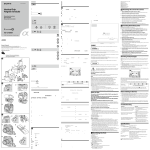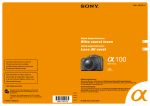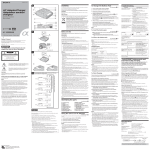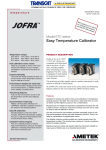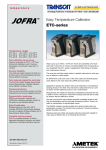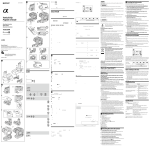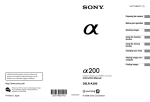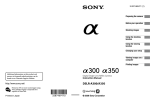Download Sony Alpha DSLR-A100K User`s Manual
Transcript
2-681-186-12 (1) Digital Single Lens Reflex Camera Read This First 100 DSLR-A100 Operating Instructions Additional information on this product and answers to frequently asked questions can be found at our Customer Support Website. Before operating the unit, please read this manual and “User’s Guide/Troubleshooting” (separate volume) thoroughly, and retain them for future reference. Printed on 100% recycled paper using VOC (Volatile Organic Compound)-free vegetableoil based ink. Printed in Malaysia Downloaded from ManualsCamera.com Manuals © 2006 Sony Corporation Checking the accessories supplied The number in parentheses indicates the number of pieces. • BC-VM10 Battery charger (1) • Video cable (1) • Power cord (mains lead) (1) • Shoulder strap with eyepiece cover and Remote Commander clip (1) • Rechargeable battery pack NP-FM55H (1) • Body cap (1) (Attached on the camera) • Memory Stick Duo Adaptor for CompactFlash slot AD-MSCF1 (1) • Accessory shoe cap (1) (Attached on the camera) • CD-ROM (α100 Application Software) (1) • Operating instructions: “Read This First” (this manual) (1) • USB cable (1) • Operating instructions: “User’s Guide/ Troubleshooting” (1) Note • Use only an NP-FM55H battery pack. Note that the NP-FM50 and NP-FM30 cannot be used. 2 Downloaded from ManualsCamera.com Manuals Composition of the operating instructions This manual Explains the set-up and basic operations for shooting/playback with your camera. Prepare the camera and shoot images easily. Checking the accessories supplied ............................................................................ 2 1 Prepare the battery pack ......................................................................................... 4 2 Attaching a lens ...................................................................................................... 6 3 Turn the camera on/set the clock ............................................................................ 8 4 Insert a recording medium (not supplied)............................................................. 10 5 Shoot images easily (Auto adjustment mode) ...................................................... 12 The Number of images that can be recorded ................................................. 13 Holding the camera........................................................................................ 13 Super SteadyShot function ............................................................................ 14 Focus.............................................................................................................. 15 Using the flash ............................................................................................... 16 Adjusting the diopter ..................................................................................... 17 6 View/delete images............................................................................................... 18 “User’s Guide/Troubleshooting” (separate volume) Get more friendly with your camera • Shoot with your favorite settings t Using the shooting functions • Playback with your favorite settings t Using the viewing functions Connect your camera to a PC or a printer • Enjoy various shooting/playback functions using the menu t Using the menu • Copy your images to a computer and enjoy editing them in various ways t Using your computer • Print images by connecting your camera directly to a printer (PictBridge compliant printers only) t Printing images Downloaded from ManualsCamera.com Manuals 3 Prepare the battery pack 1 Insert the battery pack. Push the battery pack until it clicks. 2 Connect the power cord (mains lead). Power cord (mains lead) CHARGE lamp Battery charger 3 Light on: Charging Light off: Completed (Normal Charge) To wall outlet (wall socket) If you continue charging the battery pack for about one more hour until it is fully charged (Full Charge), the charge will last slightly longer. • Connect the battery charger to an easily accessible wall outlet (wall socket) close by. • Even if the CHARGE lamp is not lit, the battery charger is not disconnected from the AC power source (mains) as long as it is connected to the wall outlet (wall socket). If some trouble occurs while using the battery charger, immediately shut off the power by disconnecting the plug from the wall outlet (wall socket). • When charging is finished, disconnect the power cord (mains lead) from the wall outlet (wall socket), and remove the battery pack from the battery charger. • The time required to fully charge the battery pack (supplied) (Full Charge) from when it is completely discharged at a temperature of 25°C (77°F) is approximately 235 min., and the Normal Charge time is approximately 175 min. Charging may take longer under certain circumstances or conditions. 4 Insert the charged battery pack. Lock lever While sliding the battery cover open lever, open the battery cover. Firmly insert the battery pack all the way while pressing the lock lever with the tip of the battery. 4 Downloaded from ManualsCamera.com Manuals Close the cover. Note on the battery pack Use only an NP-FM55H battery pack. Note that the NP-FM50 and NP-FM30 cannot be used. Using the AC Adaptor/charger You can connect the camera to a wall outlet (wall socket) using the AC-VQ900AM AC Adaptor/charger (not supplied). t “User’s Guide/Troubleshooting” (page 144) To check the remaining battery level Set the POWER switch to ON and check the level on the LCD monitor. Battery remaining indicator Battery remaining guidelines (white) Sufficient power remaining (white) Battery half full (white) Battery low, recording/ playback will stop soon. (red) Change the battery pack with fully charged one, or charge the battery pack. Battery exhausted. The shutter will not be released. To remove the battery pack Slide the lock lever in the direction of the arrow. Be careful not to drop the battery pack. Before removing the battery pack, check that the power is turned off. Lock lever To use your camera abroad — Power sources You can use your camera and the battery charger and the AC-VQ900AM AC Adaptor/charger (not supplied) in any country or region where the power supply is within 100 V to 240 V AC, 50/60 Hz. Use a commercially available AC plug adaptor [a], if necessary, depending on the design of the wall outlet (wall socket) [b]. • Do not use an electronic transformer (travel converter), as this may cause a malfunction. Downloaded from ManualsCamera.com Manuals 5 Attaching a lens 1 Remove the body cap from the camera and the rear cap from the lens. Rear cap Body cap • Do not leave the interior of the camera exposed to dust or water droplet, and do not touch or damage the interior. 2 Attach the lens. Orange index marks Mount the lens by aligning the orange index marks on the lens and camera. Turn the lens clockwise until it clicks into the locked position. • When attaching a lens, do not press the lens release button. • Do not use force when attaching a lens. • When shooting without the flash, using a lens hood is recommended to prevent unnecessary light from affecting your images. For details on attaching the lens hood, refer to the operating instructions supplied with the lens. 6 Downloaded from ManualsCamera.com Manuals To remove the lens Press the lens release button all the way in and turn the lens counterclockwise until it stops. Lens release button • Replace the cap on the lens and attach the body cap (or another lens) to the camera after removing the lens. Keep dust from getting inside the camera when changing lenses! If dust or debris gets inside the camera and lands on the surface of the CCD (the part that acts as the film), it may appear on the image, depending on the shooting environment. The camera is equipped with an anti-dust function to prevent dust from landing on the CCD. However, take note of the following reminders when attaching/removing a lens. • Avoid changing lenses in a dusty location. • When storing the camera, always attach a lens or the body cap. • When attaching the body cap, remove all the dust from the cap before placing it on the camera. If dust or debris gets inside the camera, select [Clean CCD] in the Setup menu, and use a commercially available blower brush to clean the CCD. t “User’s Guide/ Troubleshooting” (page 103) Downloaded from ManualsCamera.com Manuals 7 Turn the camera on/set the clock 2 1 Set the clock with the controller. Select [Yes], then press the center of the controller. • If you set the clock later, select [No] with B, then press the center of the controller. 1 Set the POWER switch to ON by sliding it in the direction of the arrow. 2 Select each item with b/B and set the numeric value with v/V. 3 Repeat step 2 to set other items. • [YYYY/MM/DD] represents the order of year, month, and day. You can change this order with v/V. 4 Press the center of the controller. • To cancel, press MENU. 8 Downloaded from ManualsCamera.com Manuals To change the date and time Select [Date/Time set] in the Setup menu and perform the procedure in step 2-2 to -4. t “User’s Guide/Troubleshooting” (page 99) When turning on the power • Unless you set the clock, “Set date and time?” appears each time the camera is turned on. To turn off the power Set the POWER switch to OFF sliding in the arrow direction. Attach the lens cap. After you remove the lens, store the camera with the body cap attached. Power Save (The camera nearly shuts down if it is not operated) If you do not operate the camera for about five seconds, the recording mode display on the LCD monitor disappears. Also, if you do not operate the camera for about three minutes, the camera turns to power saving mode and nearly shuts down (Power Save). To cancel the power save, operate the camera, for example, by pressing the shutter button halfway down. • You can change the time that must elapse to activate the function (the default settings are [5 sec.]/[3 min.]). t “User’s Guide/Troubleshooting” (page 102) Changing the language setting You can change the screen display to show messages in a specified language. To change the language setting, follow the procedure below. 1 Press MENU to display the menu. 2 Select [ ] with the controller, then press the center of the controller. 3 Select [ Language] with v/V on the contoroller, then press B. 4 Select the desired language with v/V on the contoroller, then press the center of the controller. Downloaded from ManualsCamera.com Manuals 9 Insert a recording medium (not supplied) Available recording medium for the camera “Memory Stick Duo” (using the Memory Stick Duo Adaptor for CompactFlash slot) CompactFlash/ Microdrive You can use a “Memory Stick Duo”, CompactFlash card (CF card), or Microdrive as a recording medium. • Before using a recording medium, be sure to format it using this camera. Otherwise, satisfactory performance may not be obtained. t “User’s Guide/Troubleshooting” (page 89) • When using a “Memory Stick Duo”, use the Memory Stick Duo Adaptor for CompactFlash slot (supplied). • When using the “Memory Stick Duo” with the write-protection switch, set the switch to the recording position. • For more information about the “Memory Stick” t “User’s Guide/Troubleshooting” (page 139) Insert a recording medium Front side of the label Terminal side Open the CF card cover. Insert a recording medium all the way in from the connector side as shown in the illustration. Close the cover. • Be careful not to pinch your fingers when opening the cover. • Straight insert a recording medium by pressing the center of the recording medium. Do not press the edges of the recording medium. • If a recording medium cannot be inserted all the way in, do not attempt to insert it. In such cases, check the direction of the recording medium. 10 Downloaded from ManualsCamera.com Manuals Note on the Memory Stick Duo Adaptor for CompactFlash slot Check the shape of the corner Push Memory Stick Duo Adaptor for CompactFlash slot AD-MSCF1 (supplied) To remove the “Memory Stick Duo” from the adaptor, push it once. To remove the recording medium 1 Open the CF card cover. 2 Push the CF card eject lever so that the recording medium is ejected. • The recording medium may be hot just after it has been used. Be careful when you handle it. When the access lamp is lit CF card eject lever Access lamp Never remove the recording medium, remove the battery pack, or turn off the power. The data may be corrupted. CompactFlash/Microdrive We have checked the operations, however, we cannot guarantee proper operation of all CF cards/Microdrives. • The Microdrive is a compact and lightweight hard disk drive that complies with CompactFlash Type II standards. For more information about the CF card/Microdrive t “User’s Guide/Troubleshooting” (page 141) Downloaded from ManualsCamera.com Manuals 11 Shoot images easily (Auto adjustment mode) The main functions of the camera are adjusted automatically in auto adjustment mode. Using this mode, you can shoot easily, depending entirely on the camera. However, you can change any of the settings except [Color/DEC]. t “User’s Guide/Troubleshooting” (page 49) 1 Set the mode dial to AUTO. 2 Look into the viewfinder. The subject inside 3 4 comes into focus. When using a zoom lens, turn the zoom ring, then decide on your shot. Shoot with the shutter button. Press the shutter button halfway down to focus. Focus indicator (Indicates the status of the autofocus (page 15)) Press the shutter button fully down to shoot. The shutter sounds. Sensor used for focus adjustment (Illuminated in red briefly to indicate the point of focus.) • The image is not displayed on the LCD monitor before the recording is completed. Use the viewfinder for monitoring. • After shooting, the recorded image is displayed for two seconds on the LCD monitor. You can change the display time. t “User’s Guide/Troubleshooting” (page 84) • While the image is being recorded, the access lamp lights. Do not remove the recording medium or turn off the power while this lamp is lit. 12 Downloaded from ManualsCamera.com Manuals The Number of images that can be recorded Once you insert a recording medium into the camera and set the POWER switch to ON, the number of images that can be recorded (should you continue to shoot using the current settings) is displayed on the LCD monitor. To identify items on the LCD monitor t “User’s Guide/ Troubleshooting” (page 22) • The number of images that can be recorded on a recording medium differs depending on the capacity of the recording medium, the image size setting, and the image quality setting. t “User’s Guide/ Troubleshooting” (page 27) • If “--E-” flashes after shooting, the write-protect switch of the “Memory Stick Duo” is set to the LOCK position. Set the switch to the recording position. • If “0000” is flashing in red, the recording medium is full. Replace the recording medium with another one, or delete images in the current recording medium (pages 10, 18). • Since the data amount of each image is different, the remaining number of recordable images may not change after shooting. • Preparing a spare recording medium is recommended when you intend to shoot many images, such as when you are on a trip. Holding the camera Hold the camera steady to avoid blurring of images due to hand movement. Turning on the Super SteadyShot function is also recommended (page 14). • Grip the camera firmly with your right hand, keep your elbows at your side, and support the lens with the palm of your left hand. • Step out with one foot to stabilize your upper body. Leaning against a wall or putting your elbow on a table will also provide support. • When shooting in dark light without the flash, shooting in macro, or using a telephoto lens, camera shake that cannot be compensated for by the camera tends to occur. In such cases, turn off the Super SteadyShot function and use something to stabilize the camera, such as a tripod. Downloaded from ManualsCamera.com Manuals 13 Super SteadyShot function 1 Make sure that the (Super SteadyShot) switch is set to ON to activate the function. 2 Press the shutter button halfway down, and then press it fully down. (Camera-shake warning) indicator (Super SteadyShot) switch Super SteadyShot scale Super SteadyShot scale This scale is displayed whenever the Super SteadyShot function is activated. A higher scale indicates more pronounced camera-shake (on a scale of five). When the Super SteadyShot function is deactivated, the scale will not be displayed. (Camera-shake warning) indicator This indicator flashes regardless of the status of the Super SteadyShot function. It indicates the likelihood of camera-shake calculated from the shutter speed and focal length. If the indicator flashes, reduce the camera-shake by setting the (Super SteadyShot) switch to ON or using the built-in flash or a tripod. • The Super SteadyShot function may not work optimally when the power has just been turned on, when the subject has just entered the frame, or when the shutter button has been pressed all the way down without stopping halfway. Wait for the Super SteadyShot scale to go down, and then press the shutter button down slowly. • When the subject is within a very close range, such as in macro, the Super SteadyShot function may not be able to cancel out the effect of camera-shake. In such cases, deactivate the Super SteadyShot function and mount the camera on a tripod. • This Super SteadyShot function can reduce the effect of camera-shake by the equivalent of approximately 2 to 3.5 increments of shutter speed. The Super SteadyShot function is less effective with moving subjects or with shutter speeds of 1/4 second or longer, which are typically used in night-time shooting. In such cases, deactivate the Super SteadyShot function and mount the camera on a tripod. • When using a tripod, deactivate the Super SteadyShot function as it will not be fully effective. 14 Downloaded from ManualsCamera.com Manuals Focus Within the wide focus frames, there are nine sensors (local focus frames) to lock the focus on the subject. Press the shutter button halfway down, and the sensor in the focused area illuminated briefly in red to indicate where the focus is. Wide focus frames Local focus frames Focus indicator Focus indicator Looking into the viewfinder or pressing the shutter button halfway down triggers the autofocus system. The focus indicator in the viewfinder indicates the status of the autofocus system. Focus indicator Status z lit Focus locked. Ready to shoot. lit Focus is confirmed. Focal point moves following a moving subject. Ready to shoot. lit Still focusing. You cannot release the shutter. z flashing Cannot focus. The shutter is locked. • If the subject is closer than the minimum shooting distance of the attached lens, the focus cannot be confirmed. Make sure you put enough distance between the subject and the camera. • You can manually release the shutter even when the indicator is flashing. t “User’s Guide/Troubleshooting” (page 93) • The focus may not be confirmed by just looking into the viewfinder when the camera is mounted on a tripod or a monopod, or is placed on a table, etc. Pressing the shutter button halfway down sets the focus. Downloaded from ManualsCamera.com Manuals 15 Using the flash Fn button Function dial Pull the built-in flash up with your finger. The camera triggers the flash if the amount of light is insufficient. Push the flash down with your finger when not using it. • If you want to make sure the flash fires without fail, set the flash mode to dial and Fn button. t “User’s Guide/Troubleshooting” (page 54) (Fill-flash) using the function Flash indicators in the viewfinder flashing: The flash is being charged. When the indicator flashes, you cannot release the shutter. lit: The flash has been charged and is ready to fire. The flash range The flash range depends on the aperture value and ISO sensitivity setting. The following chart shows the approximate flash range when the ISO sensitivity is set to [AUTO]. Aperture ISO sensitivity t “User’s Guide/Troubleshooting” (page 44) Aperture Flash range F2.8 1.4 - 8.6 m (55 1/8 - 338 5/8 inches) F4 1.0 - 6.0 m (39 3/8 - 236 1/4 inches) F5.6 1.0 - 4.3 m (39 3/8 - 169 3/8 inches) Notes on using the built-in flash When shooting with the built-in flash, the lens may block the flash light and a shadow may appear on the lower part of the image. Be careful about the following: • Shoot the subject at a distance of 1 m or longer. • Remove the lens hood. • The built-in flash is designed to be used with lenses with focal lengths of 18 mm or longer. 16 Downloaded from ManualsCamera.com Manuals AF illuminator When you press the shutter button halfway down with the built-in flash pulled up in dark surroundings, the flash may be triggered. This is an AF illuminator allowing the camera to focus more easily on a subject. • The range of the AF illuminator is approximately 1 to 5 m (39 3/8 to 196 7/8 inches). • AF illuminator does not operate when [AF mode] is set to (Continuous AF) or the subject is moving. (The (focus) indicator lights) • The AF illuminator may not operate with focal lengths of 300 mm or longer. • When an external flash is attached, the AF illuminator of the external flash is used. • The AF illuminator does not operate when [AF illuminator] in the Custom menu is set to [Off]. t “User’s Guide/Troubleshooting” (page 95) Adjusting the diopter Eyecup Diopter-adjustment dial Adjust the diopter-adjustment dial to your eyesight until the indicators appear clearly in the viewfinder. • Turn the dial toward + when you are far-sighted, toward – when you are near-sighted. The direction is indicated on the dial if you remove the eyecup. t “User’s Guide/Troubleshooting” (page 41) • Training the camera on the light allows you to adjust the diopter easily. Downloaded from ManualsCamera.com Manuals 17 View/delete images 1 Press (Playback). 2 Select an image with b/B on the controller. • You can easily view next/previous image by turning the control dial. (Enlarge) button (Display) button (Delete) button To return to the recording mode • Press (Playback) again. • Press the shutter button halfway down. To delete images 1 Display the image you want to delete and press (Delete). 2 Select [Yes] with b, then press the center of controller. To cancel delete operation Select [No], then press the center of the controller. 18 Downloaded from ManualsCamera.com Manuals You can view playback images on the index screen with the (Display) button or enlarge the image with the (Enlarge) button. t “User’s Guide/Troubleshooting” (pages 72, 77) Downloaded from ManualsCamera.com Manuals 19



















